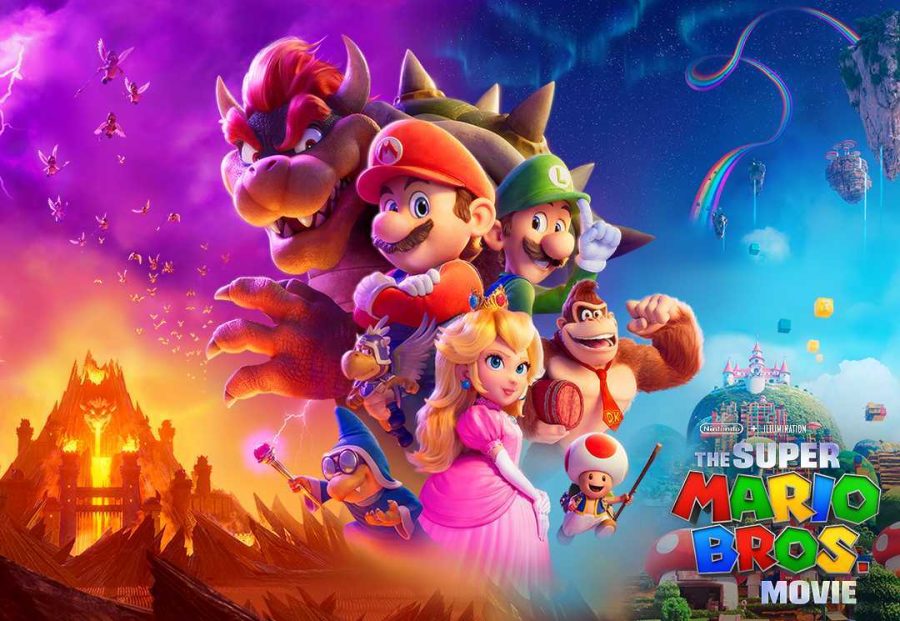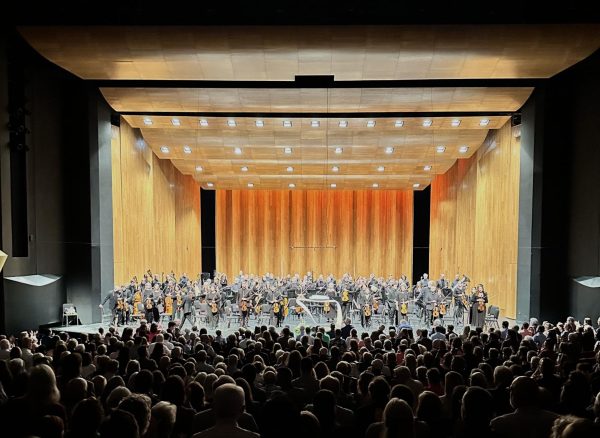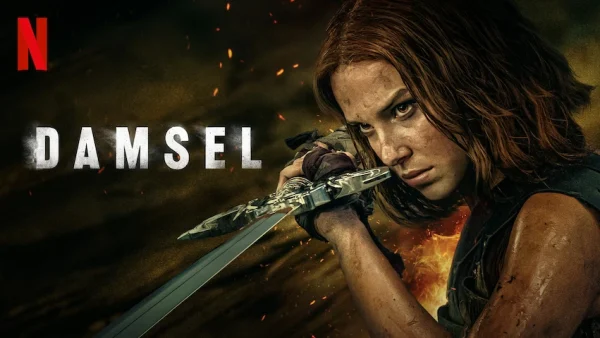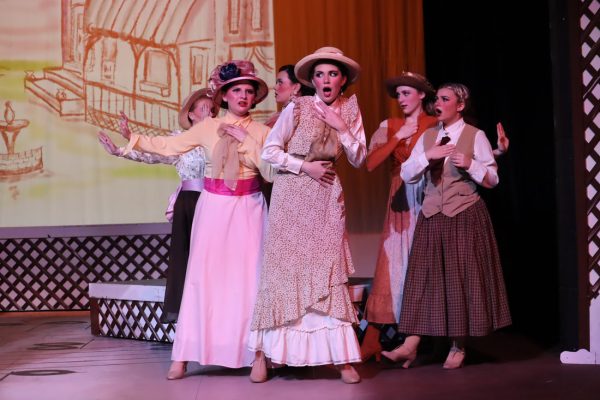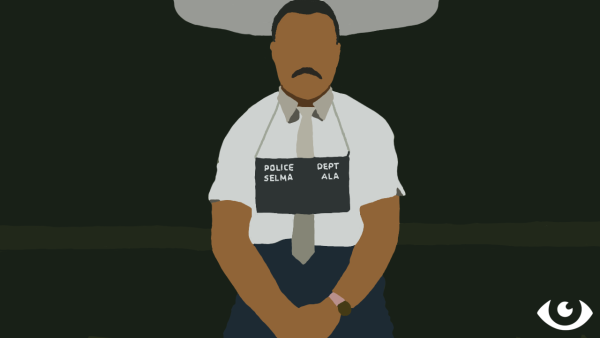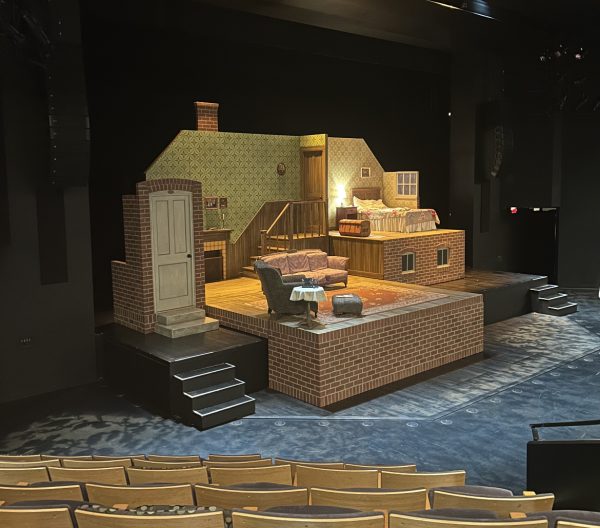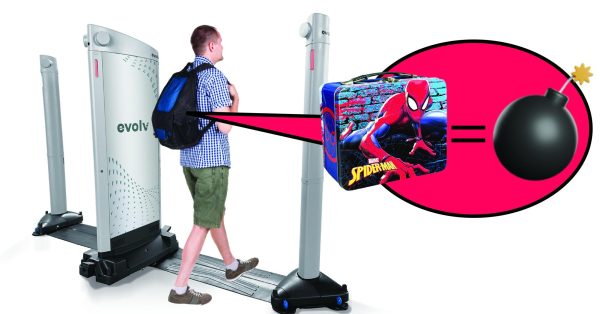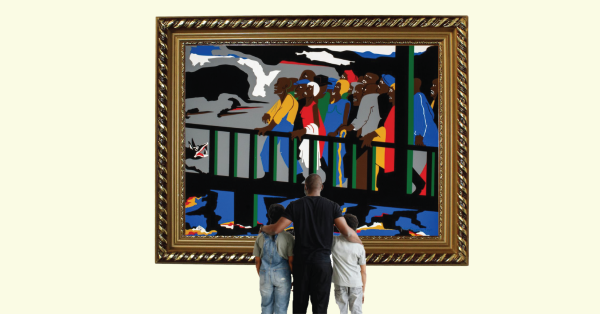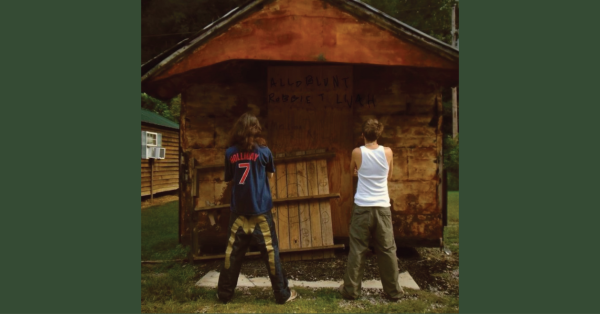REVIEW: The Mario movie is a fun experience for all ages
Mario and Luigi remain two of the most recognizable characters of all time after the release of the Super Mario Bros. Movie. Photo courtesy of Illumination
April 22, 2023
Spoiler alert: this review contains minor plot details and dialogue from the movie.
“It’s-a me, Mario!”
His face was inescapable as I entered the theater. The mustachioed man in the red hat and overalls peered down at me from every corner, from posters and cardboard cutouts. His face was harmless, but he had the entire box office under his gloved thumb. Nobody could run from the fact that the weekend was dominated by the release of the Super Mario Bros Movie.
Despite all the promotion for his new movie, Nintendo’s chief property needs no introduction. The Super Mario Bros. have been an established pop culture icon since their 1983 video game debut, and remain two of the most recognizable characters of all time. Nintendo is renowned for high-quality products, but they are also known for holding their intellectual property tight to the company’s chest. Nintendo hasn’t tried a Super Mario movie since a live-action attempt in 1993 that flopped in theaters for an avant-garde, experimental plot that didn’t reflect the game it was based on. If Nintendo was willing to partner directly with Illumination, the studio behind the pop culture powerhouse that is the Minions, then I felt assured that this movie would manage to provide me with a good time.
The movie opens in Brooklyn, New York. Mario (Chris Pratt) and his brother Luigi (Charlie Day) are struggling plumbers living with their family, bearing the weight of their family’s ridicule for their failing plumbing ventures. Descending into the sewers of Brooklyn in an attempt to prove their worth, they quickly find themselves sucked into a pipe that whisks them away to the magical Mushroom Kingdom.
Something that came as an enjoyable surprise to me throughout the opening was the sheer number of references to Mario’s media history that found their way into the movie. As a lifelong fan of the Super Mario series, I lost count noting all the throwaway jokes and set details that called to mind the video games and television shows of Mario’s past. Even other obscure Nintendo properties, such as Star Fox or Punch-Out!! found a moment in the spotlight if you peered into the background of Mario’s room. However, as would become a theme throughout the movie, there was a fair amount of details left unexplained. Why does Brooklyn have a magical pipe leading to another dimension hidden in its sewers? The movie took a very simple approach and assumed the audience would accept everything at face value- a fair approach for younger and more casual viewers, but for older and more mature audiences, a little too much was left without development.
As the brothers are warped to another dimension, they’re split up. Luigi ends up in the kingdom of the evil beast Bowser (Jack Black), where the green-garbed Italian is quickly captured; Mario ends up in the Mushroom Kingdom, a land of tiny mushroom creatures called Toads, and immediately begins searching for his brother. The pacing never lets up, and within minutes, Mario is talking with the only other human he’s found there: Princess Peach (Anya Taylor-Joy), the monarch of the Mushroom Kingdom. With the need to find his brother, and the Mushroom Kingdom falling under threat, Mario and Peach immediately set off on a journey for the ages.
With a relatively short runtime of 92 minutes, the Mario Movie necessitates a snappy pace. However, the need to be ever-pushing the plot forward led to several unrealistic situations. For instance, Mario is the first human that Peach has ever seen, due to her Mushroom Kingdom upbringing. Despite this, Peach immediately trusted Mario without reservation and invited him on her expedition. The unexplained pipe in Brooklyn that brings the Mario Bros. to another dimension is likely because of this need to have a quick, easy reason to forward the plot. Yet, the pacing still felt relatively rushed throughout the entire film. The action rarely lets up from start to end, and while this kept me engaged, I feel like some extra runtime would have benefited the movie, satiated the desire I had at the end of the movie for more and allowed for more believable scenes.
It could be argued that the simplicity and fast pace of the movie are a result of the movie being geared towards children. However, I disagree with the idea that this movie is primarily made for that demographic. For one, I was surprised by the amount of times that death was mentioned. One of Bowser’s prisoners speaks at length about “the sweet release of death.” The Mushroom Kingdom is nearly razed to the ground by Bowser’s army, and Luigi is nearly the victim of human sacrifice in a pool of lava. Similarly to other Illumination films, like Despicable Me, mature themes are casually included in an innocent-looking package in order to appeal to older audiences. For Mario fans who have loved the franchise since the 80s, or even mature newcomers to the series, this makes the film more enjoyable, but it doesn’t fix the frenetic pacing.
One of the aspects of the movie that has proven controversial since its first reveal has been the choice of voice actors. The Super Mario Bros. Movie has been the subject of concern due to the lack of diversity in the cast, and the fact that the movie might be using high-profile actors like Chris Pratt for star power rather than talent. When watching the film, I found the voice acting to be fine; not excellent, not terrible, but fine. Chris Pratt’s performance as Mario was not noteworthy, but it didn’t feel wrong at any moment either. Anya Taylor-Joy as Peach felt like a fitting voice, but her performance needed more emotional inflection. Jack Black as Bowser was my favorite performance, as he sounded genuinely passionate towards his role. Overall, though, the voice acting was simply adequate.
This movie included the groundbreaking choice to make Luigi somewhat of a captured “damsel in distress”. I believe this worked well for inclusivity, because Princess Peach, who normally occupies that role in the video game series, is shown in the movie to be a strong leader and a fighter on par with Mario and Luigi themselves. This was a great step for representation, and providing Peach with an active role in protecting her kingdom opens the door for similar representation in other popular media.
Something that exceeded my expectations was the music of the film. Bryan Tyler’s orchestral score for the movie prominently featured some of the most famous motifs from the Mario video games. From the original Super Mario Bros‘ iconic Overworld Theme to more obscure tracks from Super Mario Bros. 3, the orchestral score provides Mario fans with a smorgasbord of recognizable tunes that fit in line with the tone of the movie.
Overall, this movie was a positive experience for me, and despite some drawbacks in the acting and plot department, the familiarity of Super Mario was like a warm embrace from childhood. The multitude of references and the fitting music made the movie enjoyable, and several jokes that leaned towards the mature side kept my interest. I would give the Super Mario Bros. Movie a four out of five stars, and recommend it for all audiences, ranging from children already well-acquainted to Mario to to old-school gamers who still dust off their Nintendo Entertainment System every once in a while. This movie is a simple, inoffensive good time, and I thoroughly enjoyed it. If you’re interested in seeing it, you definitely should.
“Let’s-a go!”


